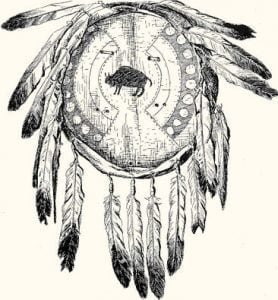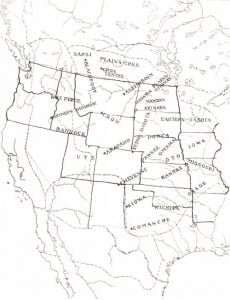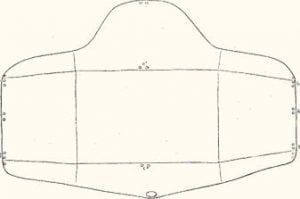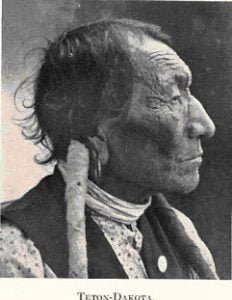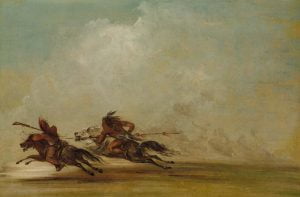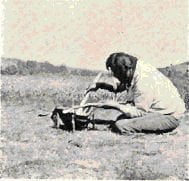North American Indians Of The Plains
Wissler, Clark. North American Indians Of The Plains. Smithsonian Institution, New York. 1920.
Transportation of Plains Indians
Before the introduction of the horse, the Plains Indians traveled on foot. The tribes living along the Mississippi made some use of canoes, according to early accounts, while those of the Missouri and inland, used only crude tub-like affairs for ferry purpose. When first discovered, the Mandan, Hidatsa, and Arikara had villages on the Missouri, in what is now North Dakota, but they have never been credited with canoes. For crossing the river, they used the bull-boat, a tub-shaped affair made by stretching buffalo skins over a wooden frame; but journeys up and down the bank were made on foot. … Read more
Tipi and Earth Lodges of the Plains Tribes
One of the most characteristic features of Plains Indian culture was the tipi. All the tribes of the area, almost without exception, used it for a part of the year at least. Primarily, the tipi was a conical tent covered with dressed buffalo skins. A carefully mounted and equipped tipi from the Black-foot Indians stands in the center of the Plains exhibit. Everywhere the tipi was made, cared for, and set up by the women. First, a conical framework of long slender poles was erected and the cover raised into place. Then the edges of the cover were staked down … Read more
Social Distinction Amongst Plains Indians
Social Distinction. There being no such thing as individual ownership of land, property consisted of horses, food, utensils, etc. These were possessed in varying degrees by the individual members of a tribe, but in no case was the amount of such property given much weight in the determination of social position. Anyone in need of food, horses, or anything whatsoever, was certain to receive some material assistance from those who had an abundance. Beginning at the top, we have Bear-chief (a) on foot surprised by Assiniboin Indians but he escaped; (b) Double-runner cut loose four horses; (c) Double-runner captures a … Read more
Religion and Ceremonies of the Plains Tribes
The sacred beliefs of these Indians are largely formulated and expressed in sayings and narratives having some resemblance to the legends of European peoples. There are available large collections of these tales and myths from the Blackfoot, Crow, Nez Perce, Assiniboin, Gros Ventre, Arapaho, Arikara, Pawnee, Omaha, Northern Shoshoni, and less complete series from the Dakota, Cheyenne, and Ute. In these will be found much curious and interesting information. Each tribe in this area has its own individual beliefs and sacred myths, yet many have much in common, the distribution of the various incidents therein forming one of the important … Read more
Plains Indians Use of Rawhide
The Use of Rawhide. In the use of rawhide for binding and hafting (handle or strap), the Plains tribes seem almost unique. When making mauls and stone-headed clubs a piece of green or wet hide is firmly sewed on and as this dries its natural shrinkage sets the parts firmly. This is nicely illustrated in saddles. Thus, rawhide here takes the place of nails, twine, cement, etc., in other cultures. The Partleche A number of characteristic bags were made of rawhide, the most conspicuous being the parfleche. Its simplicity of construction is inspiring and its usefulness scarcely to be over-estimated. … Read more
Plains Indian Culture
Museum collections cannot illustrate this important phase of culture; but since no comprehensive view of the subject can be had without its consideration, we must give it some space. It is customary to treat of all habits or customs having to do with the family organization, the community, and what we call the state, under the head of social organization. So, in order that the reader may form some general idea of social conditions in this area, we shall review some of the discussed points. Unfortunately, the data for many tribes are meager so that a complete review cannot be … Read more
North American Indians of the Plains
North American Indians of the Plains discusses the original content of the Hall of Plains Indians – American Museum of Natural History. This collection provides an extensive review of the houses, clothing, food, hunting, religion, language and other ethnological studies of the Plains Indians. Replete with maps and many photographs.
Map of Distribution of Forests in Western United States
The shaded portions of this map mark the areas originally covered with trees. The true plains extend from north to south along the eastern border of the Rocky Mountains. On the west, trees are found on the sides of mountains; on the east, they stretch out into the plains along the margins of the streams. Reference to the tribal map shows how the typical group ranges in the open plains while the eastern agricultural Village group lives in the partially forested belt. On the west the Plateau group appears to range in the open stretches among the mountains. Maps Usage … Read more
Map of Cultural Areas of American Indian Tribes
The divisions marked on this map are not absolute but relative. Rarely can a tribe be found anywhere that does not share some of the cultural traits of all its immediate neighbors. Yet, certain groups of tribes often have highly characteristic traits in common; hence, they are said to be of the same general culture type. Thus the tribes discussed in North American Indians Of The Plains have a number of peculiar traits whose distribution in more or less complete association is taken as indicating the geographical extent of a type of culture. The fact that these boundaries almost coincide with … Read more
Language of the Plains Tribes
As Stated at the outset, it is customary to classify peoples according to their languages. The main groups are what are called stock languages, or families. Under such heads are placed all languages that seem to have had a common origin regardless of whether they are mutually intelligible or not. Thus English and German are distinct forms of speech, yet they are considered as belonging to the same stock, or family. In North America, there are more than fifty such families, of which seven have representatives in the Plains. Only one, however, the Kiowa, is entirely confined to the area, … Read more
Industrial Arts of the Plains Tribes
Under this head the reader may be reminded that among most American tribes each family produces and manufactures for itself. There is a more or less definite division between the work of men and women, but beyond that there is little specialization. The individuals are not of equal skill, but still each practices practically the whole gamut of industrial arts peculiar to his sex. This fact greatly increases the importance of such arts when considered as cultural traits. Fire making The methods of making fire are often of great cultural interest. So far as our data go, the method in … Read more
Hunting and Food of the Plains Tribes
Since this is a discussion of the general characteristics of Plains Indians, we shall not take them up by tribes, as is usual, but by topics, Anthropologists are accustomed to group the facts of primitive life under the following main heads: material culture (food, transportation, shelter, dress, manufactures, weapons, etc.), social organization, religion and ceremonies, art, language, and physical type. Food The flesh of the buffalo was the great staple of the Plains Indians, though elk, antelope, bear and smaller game were not infrequently used. On the other hand, vegetable foods were always a considerable portion of their diet, many … Read more
Household Utensils of the Plains Indians
In a preceding section, reference was made to baskets, which in parts of the Plateau area on the west, often served as pots for boiling food. They were not, of course, set upon the fire, the water within being heated by hot stones. Pottery was made by the Hidatsa, Mandan, and Arikara, and probably by all the other tribes of the Village group. There is some historical evidence that it was once made by the Blackfoot and there are traditions of its use among the Gros Ventre, Cheyenne, and Assiniboin; but, with the possible exception of the Blackfoot, it has … Read more
Government and Societies of the Plains Tribes
The political organization of plains tribes was rather loose and in general quite democratic. Each band, gens, or clan informally recognized an indefinite number of men as head men, one or more of whom were formally vested with representative powers in the tribal council. Among the Dakota, there was a kind of society of older men, self-electing, who legislated on all important matters. They appointed four of their number to exercise the executive functions. The Omaha had a somewhat similar system. The Cheyenne had four chiefs of equal rank and a popularly elected council of forty members. Among the Blackfoot … Read more
Games of the Plains Tribes
Amusements and gambling are represented in collections by many curious devices. Adults rarely played for amusement, leaving such pastime to children; they themselves played for stakes. Most American games are more widely distributed than many other cultural traits; but a few seem almost entirely peculiar to the Plains. A game in which a forked anchor-like stick is thrown at a rolling ring was known to the Dakota, Omaha, and Pawnee. So far, it has not been reported from other tribes. Hoop Game Another game of limited distribution is the large hoop with a double pole, the two players endeavoring to … Read more

